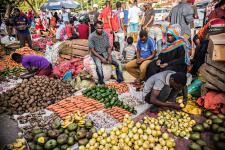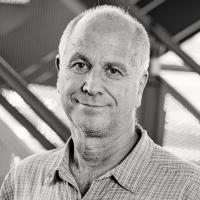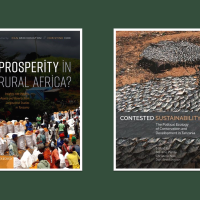From tin roofs to village business

Since the 1990s, Tanzania has been one of the world's major recipients of development aid. Along with the aid followed development researchers who, together with local universities, started research projects in the country. In recent years, a group of these researchers returned to 37 of the villages they first visited back in the 80s and 90s. In total, they re-interviewed 1,100 people to investigate the development in Tanzania's countryside since they first visited the country. The results are now collected in the book "Prosperity in Rural Africa? Insights into Wealth, Assets, and Poverty from Longitudinal Studies in Tanzania", published by Oxford University Press.
Market, China and social services
One of the book's contributors is Esbern Friis-Hansen, a Senior Researcher at DIIS, who revisited 3 marginalized villages in Tanzania's southwestern Njombe region.
- It is clear across the chapters of the book that the last 5-10 years in particular have brought a positive development in the form of the agricultural transformation. It is difficult to say exactly what drove the development, as its drivers vary greatly from place to place. At least in part, the development is the result of the market beginning to work. Better opportunities to sell products are available and, in addition, Tanzania has opened up for imports from China. An example of this is small mobile sawmills which allow for the pine forestry industry to supply resources to support the construction boom in Dar Es Salaam. PVC pipes are purchased for irrigation, along with other agricultural machinery. The interesting thing is that this development only happened recently and thus arrived 10-15 years after the major World Bank programs of the 90s which introduced privatization and state cuts in order to leave more to the market, according to Esbern Friis-Hansen.
-In addition, the development is also related to the fact that the rural population has gained better access to social services such as water, health clinics and schools. This is a development at national level that has largely been funded by donors. This is the reverse development of Asia or Europe, where an increase in productivity was followed by better services. Here the services come before production, and the latter therefore has no bearing on the former. It is only within the last 5-10 years that production has caught up, says Esbern Friis-Hansen.
Population: 61 million
Agriculture generates 25% of the GDP and employs 65% of the country's households
The rural population itself defines poverty
The researchers used a special method to measure the development over time:: a well-being ranking. Roughly speaking, the method entails the rural population itself setting the criteria for what they experience as poverty. The average is defined as having enough to eat and being able to take care of oneself. In addition, the method focuses on material wealth instead of consumption as a parameter for prosperity. It is the same method that the researchers used during their first visit, making it easy to compare the results over time. In Maliwa village, which Esbern Friis-Hansen revisited, the percentage of poor people decreased from 85 percent in 1984 to 25 percent in 2017.
- The figures show that the number of very poor people, those who are not getting enough food, has fallen dramatically. Similarly, the middle group has increased from 5 to 50 percent. In 1984, there were very few that were better-off and many poor. Now there are many more who live under better material conditions, explains Esbern Friis-Hansen.
- In the 80s, one of the local definitions of wealth was whether people had a tin roof on their house. Today, everyone has a tin roof, so now a person’s wealth is established on the basis of whether they have a water supply and a toilet inside the house, whether they have glass windows, whether they have solar cells and a TV and refrigerator. The interesting thing is that even though the population's criteria for prosperity and poverty have increased, they also estimate that today they are much better off economically.
In the study, the researchers also take a closer look at working relationships as an expression of economic development.
- In the 80s, the poor - and there were many of them - worked once or twice a year for the more affluent. They planted crops for them before planting their own. In this way, they got food or money to pay for schooling. In addition, there was a mutual labor system where people worked on each other's fields in shifts. Today, the better-off have two or three employees who work year-round on their land. In addition, there are many more who do not own land but instead work as day laborers. For them, too, wages have increased considerably. The day laborers do not get rich, but they are not nearly as poor as they used to be. Today they can afford schooling and food.
DANIDA-watered tomatoes
As more people have received training and the market has begun to function, more and more young people have found new ways to develop agriculture. One of the book's examples is a DANIDA-funded water supply programme started in the 80s. This phenomenon has given rise to a slightly different economic development than the programme was originally intended to foster.
"When the project was initiated, it was to intended to ensure the supply of clean drinking water for the villages in southwestern Tanzania. It succeeded, but today the water is also used to germinate tomatoes. Thanks to the water, tomato growers in the area do not have to wait for the rain. Instead, they start growing the tomatoes a month before the rainy season. This gives them a big head start over many other tomato growers. They can sell their tomatoes a month before everyone else, which allows them to charge higher prices than later in the season.
According to Esbern Friis-Hansen, the case of tomato growers is a good example of how rural Tanzania has developed over the past 20-30 years.
"When we first visited twenty years ago, a prosperous man was typically in his fifties and growing corn on a large tract of land. Today, the prosperous are young men. They have typically attended higher primary school, have learned to do arithmetic and are generally smart at doing business. They do not need more than a few hectares of land, which they cultivate intensively with tomatoes. They use the surplus to buy up crops from the older farmers and then sell them off when prices have risen. They operate 2-3 different business models throughout the year. Initially, they produce one crop and buy up crops from the others. Then they produce another crop and buy up more crops. They are more like businessmen. After a few years they might have a tractor and a truck and a new house.
Like many other developing countries, Tanzania has undergone significant urbanization. However, unlike elsewhere, the rural-urban connection has often been maintained in Tanzania. This leads to more local investments that also help drive agricultural development.
"People in the cities are increasingly investing in the countryside. In Tanzania, we are not seeing vicious foreign investors buying up agricultural land on a large scale. On the contrary, there are many so-called "domestic investors" who may live in the cities, but in many cases have a relation to the rural area in which they invest. This helps to create much of the most important economic development in the southern part of Tanzania," says Esbern Friis-Hansen.
DIIS Experts


